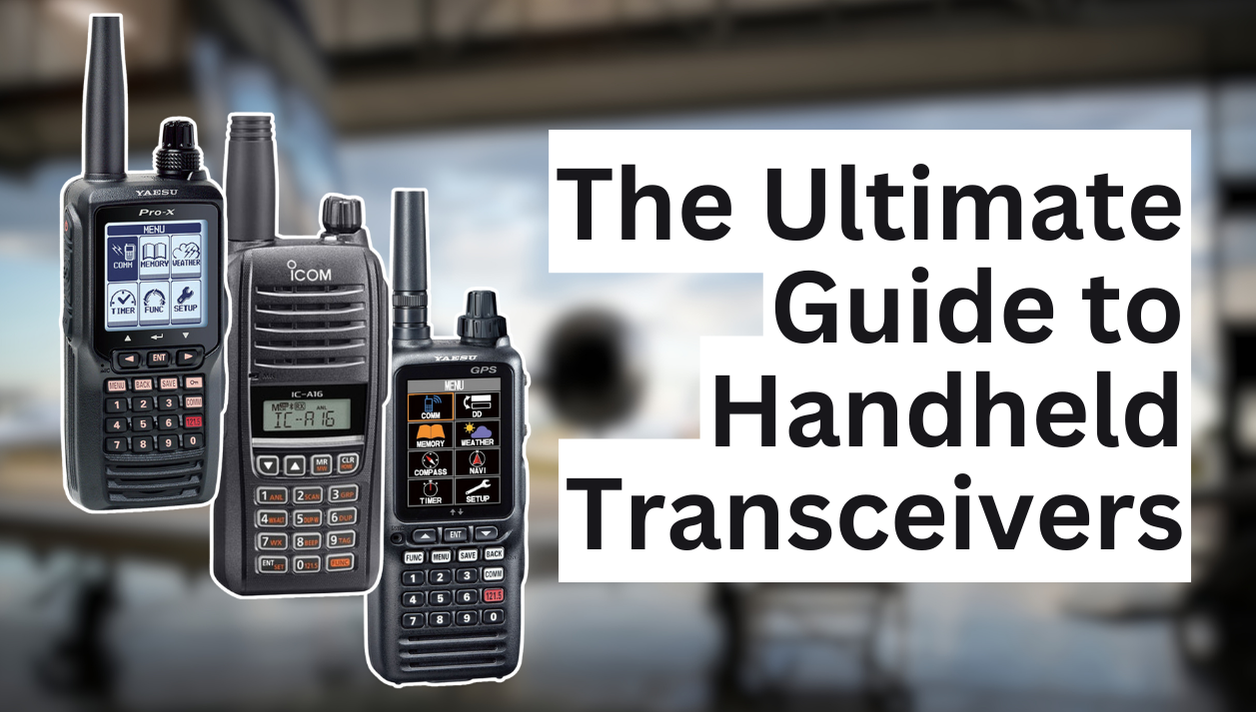
Jump to:
Whether you're a student pilot just getting started or a seasoned aviator looking for reliable backup equipment, a handheld aviation radio is one of the most versatile tools you can own. These portable transceivers offer critical backup communication and navigation capabilities when you need them most, especially in the event of panel-mounted radio failure.
Unlike base station radios or panel mount transceivers, which are designed for fixed installations in aircraft or ground vehicles, handhelds are compact, battery-powered, and built for flexibility on the go.
Handheld transceivers are used for:
- Backup communication if onboard radios fail
- Backup navigation capability
- Practicing aviation communication as a student
- Receiving weather updates and ATIS before engine start, saving time and fuel
Transceivers act as a portable communication lifeline. Because they’re not tied to a specific aircraft, you can take them from plane to plane or use them as part of your flight training toolkit. We'll cover essential features and highlight the best handheld aviation radio models available to help you make the most informed decision possible.
Capabilities: Scanner, Comm-Only, NAV/COM
Transceivers come with varying levels of functionality, so it's important to choose one that suits your intended use.
There are three primary types:
- Scanner: Listen-only capability over Airband frequencies.
- Comm-Only: Transmit and receive over Airband frequencies.
- NAV/COM: Adds the ability to receive different navigation signals depending on model.
Comm-Only Transceivers
Comm-only transceivers are the most commonly used handheld radios. They transmit and receive over Airband frequencies.
Key Features
- Compatible with aviation headsets via an adapter (included with some radios, others will require an add-on accessory)
- Pre-programmable frequencies
- Compact and lightweight options
NAV/COM Transceivers
NAV/COM transceivers offer all the same features/capabilities as Comm-only, with the added ability to navigate using various Navigation signals.
Ideal For
- Aircraft without built-in avionics
- Pilots who prefer full redundancy
- Long-term value seekers
Features to Consider
- Channel Recall: Easily toggle between your last 10 used frequencies.
- Battery Options: Most models come with both.
- Lithium-Ion rechargeable pack (great for regular use)
- Alkaline tray (ideal for emergencies)
- Bluetooth Capability: Built-in Bluetooth transceivers can pair with Bluetooth aviation headsets and reduce cockpit clutter; no adapter needed.
Bluetooth-Enabled Transceivers
How to Choose the Right Transceiver
Selecting the best handheld aviation transceiver ultimately comes down to how, where, and how often you intend to use it. If you plan to operate your radio in-flight, a headset adapter is absolutely essential; without it, cockpit noise will overpower any attempt at clear communication. Many radios come with one included, but for those that don’t, adapters are easily available.
Your frequency of use is a major factor. If you only plan to use your handheld in emergencies or as a backup, a budget-friendly model may be all you need. On the other hand, regular flyers or CFIs may want to invest in a more feature-rich unit that offers durability, ease of use, and advanced functions like Bluetooth or iNavigation integration. Those who value wireless simplicity should look for a Bluetooth-compatible model, which eliminates the need for headset adapters and reduces cockpit clutter.
Pilots who fly without a panel-mounted Navigation or Communication system, or simply want added redundancy, should strongly consider a NAV/COM transceiver, which provides access to different types of navigation capabilities. If that sounds like overkill for your use, a Comm-only unit will likely do just fine, especially if your primary concern is communication rather than navigation.
Display and usability also matter. Larger screens and keypads make it easier to change frequencies in-flight, especially during turbulence or low-light conditions. Most modern models also include memory recall features for previously used channels, which simplifies frequency management en-route.
Battery flexibility is often overlooked, but crucial. Most models today come with both a rechargeable lithium-ion battery and an alkaline battery tray. If your radio is likely to live in your flight bag until an emergency, we recommend carrying AA batteries and a tray for added peace of mind.
For a deeper dive into all the features, like channel memory, power output, water resistance, and weight, our Transceiver Comparison Chart provides a detailed side-by-side breakdown of every current model we carry. And if you're still unsure where to begin, our article 6 Things to Consider When Choosing a Handheld Aviation Radio is a great place to start.
Whether you're equipping your first cockpit or upgrading for greater capability, the right handheld transceiver is a smart investment in safety, preparedness, and clear communication. Happy flying!
